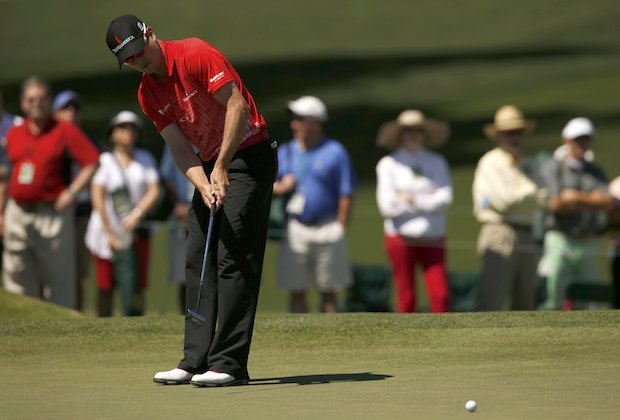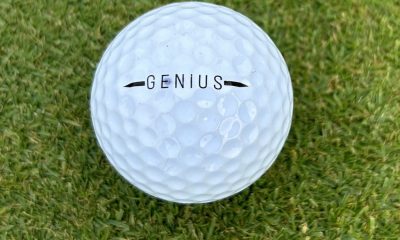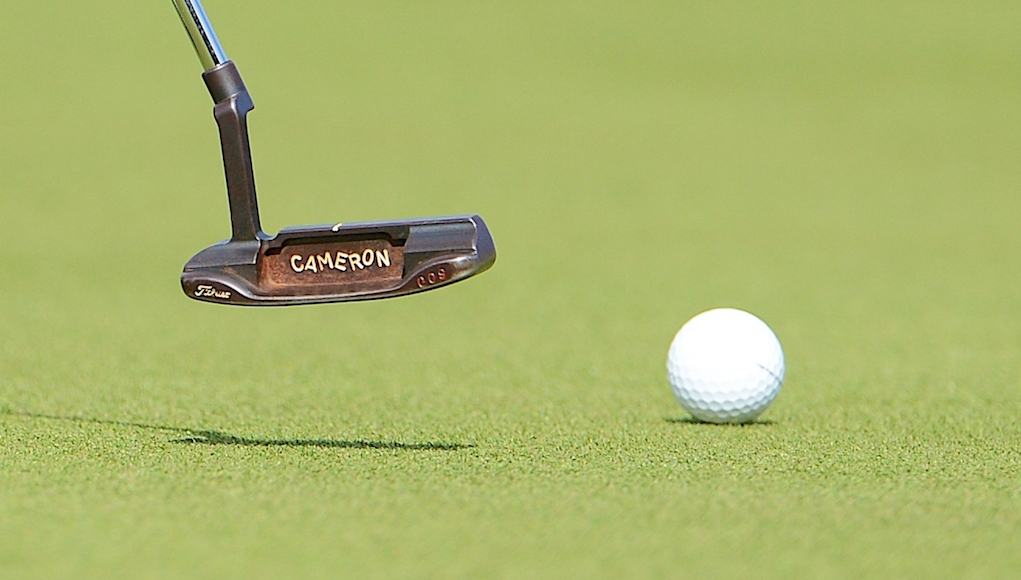Instruction
How much do mishits matter in putting?

Whenever you impact a putt, the ball is programmed with all its directional data. It is at that point that a golfer’s consistency is either compromised or enhanced by the actions of impact alignments.
Impact alignments will either make or break a good putter. In this article, I will assume you have perfect alignments (as shown below), which would program the ball’s reactions in a consistent manner from putt to putt and day to day.

Perfect impact alignments provide a neutral club shaft at impact, a flat forward wrist and a bent rear wrist.
In my putting research, I use several high-tech tools to examine the putting strokes of my clients. The two I will use in this article are AMM’s 3D Motion Analysis System, which tracks the biomechanics of the various parts of the body during the stroke, as well as Quintic’s Skid and Roll Putting Launch Monitor, which shows the actions of the ball from zero to 12 inches of movement.
Ball Roll Angle (BRA): Positive numbers show forward roll, while negative numbers show backspin.
Vertical Bounce (VB): Positive numbers show a ball that is airborne, while a negative number shows a ball on the grass.
There are several things that ball impact programs during the putting stroke, all of which we will correlate here with the data below from Quintic:
- Ball Roll: Does the ball have forward-rolling or backward-rolling characteristics? How much at each inch of ball movement (measured in degrees)?
- Ball Sidespin: How much sidespin does the ball have and what does this do to the ball’s roll (measured in degrees)?
- Ball Speed: How fast does the ball leave the blade (measured in feet per second)?
- Vertical Bounce: Does the ball jump into the air or dive into the ground (measured in inches)?
The data below examines three sample putters from leading putter makers. All putters in this study were custom made with the same length, loft and lie to ensure the most accuracy possible in the data below. The three putters also possess and market to their consumers the benefits of their roll-enhancing inserts, which we put to the test for this article.
The takeaway? These putters have inserts with grooves that help impart more forward roll than their smooth-faced counterparts. While no insert can fix issues that you might have with forward roll, they can all enhance the possibility that you will impart more over-spin to your putts than you do currently. However, the combination of proper impact alignments coupled with groove technology will lead to a more consistent roll off the face of the putter for most players.
The Test
Based on the data above we can deduce the following regarding impact points and their effects on the ball’s skid and roll.
1 Inch After Impact
Loft of the Putter
- Whenever the static loft of the putter is set up correctly based on a golfer’s personal impact alignments and mechanics, the ball will leave the blade in a manner that allows for minimal skid and the quickest roll possible.
- Not enough loft will drive the ball into the ground, and it will bounce up as a result.
- Too much loft will make the ball jump into the air.
Impact Centeredness
- There is little difference in the ball’s Vertical Bounce when the ball misses the center of the blade. This is more a function of the loft of the putter in general, not the horizontal impact point.
Ball Speed at Separation
- Centered Impact imparted between 8.18 to 8.40 feet/second.
- Heel Impact imparted between 7.60 to 7.93 feet/second.
- Toe Impact imparted between 7.98 to 8.32 feet/per second.
- The Toe Impact ball speed was higher due to the amount of sidespin imparted to the golf ball during impact, but this will soon cause other issues.
4 Inches After Impact
Impact Centeredness
- When the ball is impacted in the center of the blade, it encourages a more aggressive forward rolling of the ball at this stage. Between 15-to-20 degrees of forward roll is normal.
- If you are to miss the center of the blade, the toe of the putter imparts the most forward-rolling characteristics at 4 inches, but also imparts more sidespin to the ball than the heel impact.
Sidespin
- The average Heel Impact Sidespin was between 15 and 25 degrees, while the average Toe Impact Sidespin was between 25 to 35 degrees.
- Toe Impacted Side Spin causes the ball to “roll” quicker off the start, but it contributed to a lower overall “forward rolling” value at 8 inches.
8 Inches After Impact
Impact Centeredness
- The Centered Impact imparts 50 to 80 degrees of forward roll.
- The Heel Impact imparts 50 to 60 degrees of forward roll.
- The Toe Impact imparts 30 to 40 degrees of forward roll.
Sidespin
- Toe Impacts affect the ball between 4 and 8 inches, as they slow its forward roll due the amount of side spin.
After the ball has reached the 8-inch mark, it should have stopped bouncing and skidding and hopefully started to reach true roll. The quicker you can reach “true roll” the first actual 360 degree motion of the golf ball without leaving the ground the better the ball will be rolling. We cannot control the ball when it’s bouncing in the air, nor can we influence it after it hits the ground. However, we can do our part to influence and produce impact alignments and roll characteristics that can help us to reach true roll quicker.
Our job as teachers is to put you in a correctly fit putter and give you the fundamental mechanics necessary to create consistency in the ball’s actions off the blade. If we can do this, you will be on your way to becoming a better putter day in and day out because it makes a big difference.
Instruction
The Wedge Guy: Beating the yips into submission

There may be no more painful affliction in golf than the “yips” – those uncontrollable and maddening little nervous twitches that prevent you from making a decent stroke on short putts. If you’ve never had them, consider yourself very fortunate (or possibly just very young). But I can assure you that when your most treacherous and feared golf shot is not the 195 yard approach over water with a quartering headwind…not the extra tight fairway with water left and sand right…not the soft bunker shot to a downhill pin with water on the other side…No, when your most feared shot is the remaining 2- 4-foot putt after hitting a great approach, recovery or lag putt, it makes the game almost painful.
And I’ve been fighting the yips (again) for a while now. It’s a recurring nightmare that has haunted me most of my adult life. I even had the yips when I was in my 20s, but I’ve beat them into submission off and on most of my adult life. But just recently, that nasty virus came to life once again. My lag putting has been very good, but when I get over one of those “you should make this” length putts, the entire nervous system seems to go haywire. I make great practice strokes, and then the most pitiful short-stroke or jab at the ball you can imagine. Sheesh.
But I’m a traditionalist, and do not look toward the long putter, belly putter, cross-hand, claw or other variation as the solution. My approach is to beat those damn yips into submission some other way. Here’s what I’m doing that is working pretty well, and I offer it to all of you who might have a similar affliction on the greens.
When you are over a short putt, forget the practice strokes…you want your natural eye-hand coordination to be unhindered by mechanics. Address your putt and take a good look at the hole, and back to the putter to ensure good alignment. Lighten your right hand grip on the putter and make sure that only the fingertips are in contact with the grip, to prevent you from getting to tight.
Then, take a long, long look at the hole to fill your entire mind and senses with the target. When you bring your head/eyes back to the ball, try to make a smooth, immediate move right into your backstroke — not even a second pause — and then let your hands and putter track right back together right back to where you were looking — the HOLE! Seeing the putter make contact with the ball, preferably even the forward edge of the ball – the side near the hole.
For me, this is working, but I am asking all of you to chime in with your own “home remedies” for the most aggravating and senseless of all golf maladies. It never hurts to have more to fall back on!
Instruction
Looking for a good golf instructor? Use this checklist

Over the last couple of decades, golf has become much more science-based. We measure swing speed, smash factor, angle of attack, strokes gained, and many other metrics that can really help golfers improve. But I often wonder if the advancement of golf’s “hard” sciences comes at the expense of the “soft” sciences.
Take, for example, golf instruction. Good golf instruction requires understanding swing mechanics and ball flight. But let’s take that as a given for PGA instructors. The other factors that make an instructor effective can be evaluated by social science, rather than launch monitors.
If you are a recreational golfer looking for a golf instructor, here are my top three points to consider.
1. Cultural mindset
What is “cultural mindset? To social scientists, it means whether a culture of genius or a culture of learning exists. In a golf instruction context, that may mean whether the teacher communicates a message that golf ability is something innate (you either have it or you don’t), or whether golf ability is something that can be learned. You want the latter!
It may sound obvious to suggest that you find a golf instructor who thinks you can improve, but my research suggests that it isn’t a given. In a large sample study of golf instructors, I found that when it came to recreational golfers, there was a wide range of belief systems. Some instructors strongly believed recreational golfers could improve through lessons. while others strongly believed they could not. And those beliefs manifested in the instructor’s feedback given to a student and the culture created for players.
2. Coping and self-modeling can beat role-modeling
Swing analysis technology is often preloaded with swings of PGA and LPGA Tour players. The swings of elite players are intended to be used for comparative purposes with golfers taking lessons. What social science tells us is that for novice and non-expert golfers, comparing swings to tour professionals can have the opposite effect of that intended. If you fit into the novice or non-expert category of golfer, you will learn more and be more motivated to change if you see yourself making a ‘better’ swing (self-modeling) or seeing your swing compared to a similar other (a coping model). Stay away from instructors who want to compare your swing with that of a tour player.
3. Learning theory basics
It is not a sexy selling point, but learning is a process, and that process is incremental – particularly for recreational adult players. Social science helps us understand this element of golf instruction. A good instructor will take learning slowly. He or she will give you just about enough information that challenges you, but is still manageable. The artful instructor will take time to decide what that one or two learning points are before jumping in to make full-scale swing changes. If the instructor moves too fast, you will probably leave the lesson with an arm’s length of swing thoughts and not really know which to focus on.
As an instructor, I develop a priority list of changes I want to make in a player’s technique. We then patiently and gradually work through that list. Beware of instructors who give you more than you can chew.
So if you are in the market for golf instruction, I encourage you to look beyond the X’s and O’s to find the right match!
Instruction
What Lottie Woad’s stunning debut win teaches every golfer

Most pros take months, even years, to win their first tournament. Lottie Woad needed exactly four days.
The 21-year-old from Surrey shot 21-under 267 at Dundonald Links to win the ISPS Handa Women’s Scottish Open by three shots — in her very first event as a professional. She’s only the third player in LPGA history to accomplish this feat, joining Rose Zhang (2023) and Beverly Hanson (1951).
But here’s what caught my attention as a coach: Woad didn’t win through miraculous putting or bombing 300-yard drives. She won through relentless precision and unshakeable composure. After watching her performance unfold, I’m convinced every golfer — from weekend warriors to scratch players — can steal pages from her playbook.
Precision Beats Power (And It’s Not Even Close)
Forget the driving contests. Woad proved that finding greens matters more than finding distance.
What Woad did:
• Hit it straight, hit it solid, give yourself chances
• Aimed for the fat parts of greens instead of chasing pins
• Let her putting do the talking after hitting safe targets
• As she said, “Everyone was chasing me today, and managed to maintain the lead and played really nicely down the stretch and hit a lot of good shots”
Why most golfers mess this up:
• They see a pin tucked behind a bunker and grab one more club to “go right at it”
• Distance becomes more important than accuracy
• They try to be heroic instead of smart
ACTION ITEM: For your next 10 rounds, aim for the center of every green regardless of pin position. Track your greens in regulation and watch your scores drop before your swing changes.
The Putter That Stayed Cool Under Fire
Woad started the final round two shots clear and immediately applied pressure with birdies at the 2nd and 3rd holes. When South Korea’s Hyo Joo Kim mounted a charge and reached 20-under with a birdie at the 14th, Woad didn’t panic.
How she responded to pressure:
• Fired back with consecutive birdies at the 13th and 14th
• Watched Kim stumble with back-to-back bogeys
• Capped it with her fifth birdie of the day at the par-5 18th
• Stayed patient when others pressed, pressed when others cracked
What amateurs do wrong:
• Get conservative when they should be aggressive
• Try to force magic when steady play would win
• Panic when someone else makes a move
ACTION ITEM: Practice your 3-6 foot putts for 15 minutes after every range session. Woad’s putting wasn’t spectacular—it was reliable. Make the putts you should make.
Course Management 101: Play Your Game, Not the Course’s Game
Woad admitted she couldn’t see many scoreboards during the final round, but it didn’t matter. She stuck to her game plan regardless of what others were doing.
Her mental approach:
• Focused on her process, not the competition
• Drew on past pressure situations (Augusta National Women’s Amateur win)
• As she said, “That was the biggest tournament I played in at the time and was kind of my big win. So definitely felt the pressure of it more there, and I felt like all those experiences helped me with this”
Her physical execution:
• 270-yard drives (nothing flashy)
• Methodical iron play
• Steady putting
• Everything effective, nothing spectacular
ACTION ITEM: Create a yardage book for your home course. Know your distances to every pin, every hazard, every landing area. Stick to your plan no matter what your playing partners are doing.
Mental Toughness Isn’t Born, It’s Built
The most impressive part of Woad’s win? She genuinely didn’t expect it: “I definitely wasn’t expecting to win my first event as a pro, but I knew I was playing well, and I was hoping to contend.”
Her winning mindset:
• Didn’t put winning pressure on herself
• Focused on playing well and contending
• Made winning a byproduct of a good process
• Built confidence through recent experiences:
- Won the Women’s Irish Open as an amateur
- Missed a playoff by one shot at the Evian Championship
- Each experience prepared her for the next
What this means for you:
• Stop trying to shoot career rounds every time you tee up
• Focus on executing your pre-shot routine
• Commit to every shot
• Stay present in the moment
ACTION ITEM: Before each round, set process goals instead of score goals. Example: “I will take three practice swings before every shot” or “I will pick a specific target for every shot.” Let your score be the result, not the focus.
The Real Lesson
Woad collected $300,000 for her first professional victory, but the real prize was proving that fundamentals still work at golf’s highest level. She didn’t reinvent the game — she simply executed the basics better than everyone else that week.
The fundamentals that won:
• Hit more fairways
• Find more greens
• Make the putts you should make
• Stay patient under pressure
That’s something every golfer can do, regardless of handicap. Lottie Woad just showed us it’s still the winning formula.
FINAL ACTION ITEM: Pick one of the four action items above and commit to it for the next month. Master one fundamental before moving to the next. That’s how champions are built.
PGA Professional Brendon Elliott is an award-winning coach and golf writer. You can check out his writing work and learn more about him by visiting BEAGOLFER.golf and OneMoreRollGolf.com. Also, check out “The Starter” on RG.org each Monday.
Editor’s note: Brendon shares his nearly 30 years of experience in the game with GolfWRX readers through his ongoing tip series. He looks forward to providing valuable insights and advice to help golfers improve their game. Stay tuned for more Tips!




























Dennis Clark
Apr 2, 2014 at 10:00 pm
good stuff Tom…Every great putter Ive played with lips IN, bad putters lip out! This explains a lot about why.
Tom Stickney
Apr 3, 2014 at 1:04 am
Appreciate it sir. You working with tm or fs in swfl?
Dennis Clark
Apr 6, 2014 at 9:49 pm
Yea Flightscope…
Bruce Rearick
Apr 1, 2014 at 11:07 am
Tom – you can’t control it when it is on the ground either. You also make a casual comment about “sidespin”. Is it really sidespin or or the initial change in ball orientation from frame one to frame two and does this change continue to frame three?
Thanks
Bruce Rearick
Tom Stickney
Apr 1, 2014 at 3:36 pm
We can only influence impact nothing more…into frame three as well sir
Bruce Rearick
Apr 3, 2014 at 7:51 pm
How about after it touches the ground the first time?